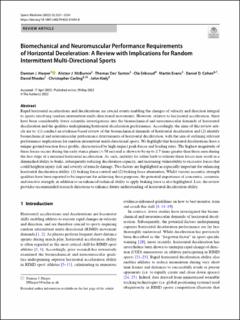| dc.contributor.author | Harper, Damian J. | |
| dc.contributor.author | McBurnie, Alistair J. | |
| dc.contributor.author | Santos, Thomas Dos’ | |
| dc.contributor.author | Eriksrud, Ola | |
| dc.contributor.author | Evans, Martin | |
| dc.contributor.author | Cohen, Daniel D. | |
| dc.contributor.author | Rhodes, David | |
| dc.contributor.author | Carling, Christopher | |
| dc.contributor.author | Kiely, John | |
| dc.date.accessioned | 2022-11-29T15:14:50Z | |
| dc.date.available | 2022-11-29T15:14:50Z | |
| dc.date.created | 2022-09-02T14:42:06Z | |
| dc.date.issued | 2022 | |
| dc.identifier.citation | Sports Medicine. 2022, 52(10), Side 2321-2354. | en_US |
| dc.identifier.issn | 0112-1642 | |
| dc.identifier.uri | https://hdl.handle.net/11250/3034826 | |
| dc.description | This article is licensed under a Creative Commons Attribution 4.0 International License, which permits use, sharing, adaptation, distribution and reproduction in any medium or format, as long as you give appropriate credit to the original author(s) and the source, provide a link to the Creative Commons licence, and indicate if changes were made. The images or other third party material in this article are included in the article's Creative Commons licence, unless indicated otherwise in a credit line to the material. If material is not included in the article's Creative Commons licence and your intended use is not permitted by statutory regulation or exceeds the permitted use, you will need to obtain permission directly from the copyright holder. | en_US |
| dc.description.abstract | Rapid horizontal accelerations and decelerations are crucial events enabling the changes of velocity and direction integral to sports involving random intermittent multi-directional movements. However, relative to horizontal acceleration, there have been considerably fewer scientific investigations into the biomechanical and neuromuscular demands of horizontal deceleration and the qualities underpinning horizontal deceleration performance. Accordingly, the aims of this review article are to: (1) conduct an evidence-based review of the biomechanical demands of horizontal deceleration and (2) identify biomechanical and neuromuscular performance determinants of horizontal deceleration, with the aim of outlining relevant performance implications for random intermittent multi-directional sports. We highlight that horizontal decelerations have a unique ground reaction force profile, characterised by high-impact peak forces and loading rates. The highest magnitude of these forces occurs during the early stance phase (< 50 ms) and is shown to be up to 2.7 times greater than those seen during the first steps of a maximal horizontal acceleration. As such, inability for either limb to tolerate these forces may result in a diminished ability to brake, subsequently reducing deceleration capacity, and increasing vulnerability to excessive forces that could heighten injury risk and severity of muscle damage. Two factors are highlighted as especially important for enhancing horizontal deceleration ability: (1) braking force control and (2) braking force attenuation. Whilst various eccentric strength qualities have been reported to be important for achieving these purposes, the potential importance of concentric, isometric and reactive strength, in addition to an enhanced technical ability to apply braking force is also highlighted. Last, the review provides recommended research directions to enhance future understanding of horizontal deceleration ability. | en_US |
| dc.language.iso | eng | en_US |
| dc.subject | ability | en_US |
| dc.subject | biomechanical performance | en_US |
| dc.subject | braking force | en_US |
| dc.subject | horizontal deceleration | en_US |
| dc.subject | neuromuscular performance | en_US |
| dc.subject | random intermittent multi-directional movements | en_US |
| dc.subject | sports | en_US |
| dc.subject | strength | en_US |
| dc.title | Biomechanical and neuromuscular performance requirements of horizontal deceleration: A review with implications for random intermittent multi-directional sports | en_US |
| dc.type | Peer reviewed | en_US |
| dc.type | Journal article | en_US |
| dc.description.version | publishedVersion | en_US |
| dc.rights.holder | © The Author(s) 2022 | en_US |
| dc.source.pagenumber | 2321-2354 | en_US |
| dc.source.volume | 52 | en_US |
| dc.source.journal | Sports Medicine | en_US |
| dc.source.issue | 10 | en_US |
| dc.identifier.doi | 10.1007/s40279-022-01693-0 | |
| dc.identifier.cristin | 2048364 | |
| dc.description.localcode | Institutt for fysisk prestasjonsevne / Department of Physical Performance | en_US |
| cristin.ispublished | true | |
| cristin.fulltext | original | |
| cristin.qualitycode | 2 | |
